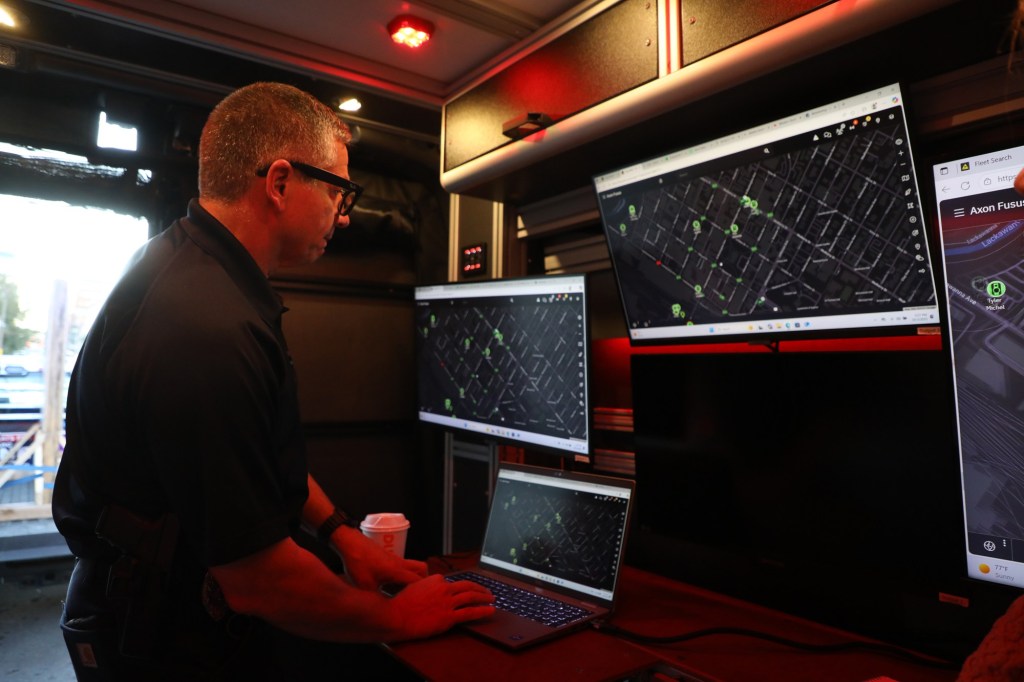Scranton police Officer Nicholas Philbin didn’t waste a second when he responded to assist with a suicidal woman with a knife in the parking lot of a Dickson City shopping center on a recent Saturday.
As he pulled out of the station, his vehicle functioned as a mini mobile unit. Dispatchers provided real time information. A computer system tracked updates. GPS tracked his route.
Philbin, a member of the department for eight years, said as technology evolves, so does police officers’ capacity to respond to incidents quickly and efficiently.
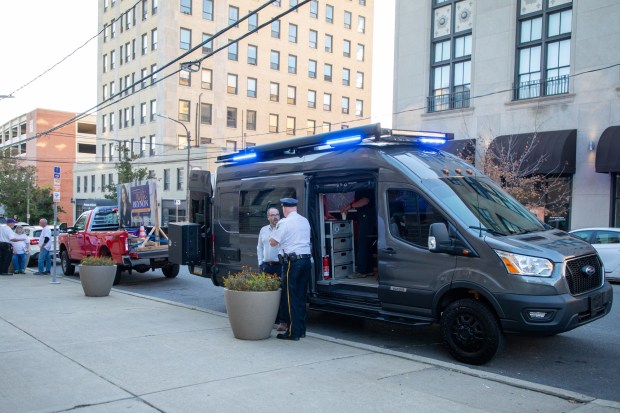 The Scranton Police Department’s mobile unit parked outside Scranton’s City Hall on Friday, Oct. 03, 2025. (REBECCA PARTICKA/STAFF PHOTOGRAPHER)
The Scranton Police Department’s mobile unit parked outside Scranton’s City Hall on Friday, Oct. 03, 2025. (REBECCA PARTICKA/STAFF PHOTOGRAPHER)
As technology affects nearly every part of daily life, the Scranton Police Department has kept up, using tools to facilitate training, improve public safety and hasten communication.
As Philbin maneuvered through traffic, he was aware of other departments on their way to the scene. The vehicle was equipped with technology that would beep if another patrol vehicle was about 30 seconds away.
Philbin’s body and vehicle cameras were active throughout the incident, which ended with the woman being taken to a hospital for mental health treatment.
After incidents, officers can write reports and complete other documentation from their vehicle laptop.
Philbin said technology keeps officers on patrol and helps them spend less time in the office writing reports. The vehicle was also equipped with a printer for citations, which were previously handwritten.
Patrolman Robert Hegedus, who manages the department’s fleet, said each vehicle functions as a mini mobile unit.
“Each car has Wi-Fi, printers. Officers can communicate with other officers,” he said. “They have literally no reason to come out of their sector unless they make an arrest.”
The department has 53 vehicles in its fleet, having added 43 new vehicles since March 2023. Vehicles are added annually through capital budget spending, a city spokesperson said.
Making the best of technology
A mobile command center, drones, virtual reality training equipment and patrol vehicles equipped with technological tools free up officers’ time and energy to assist, observe and investigate, said Police Chief Thomas Carroll.
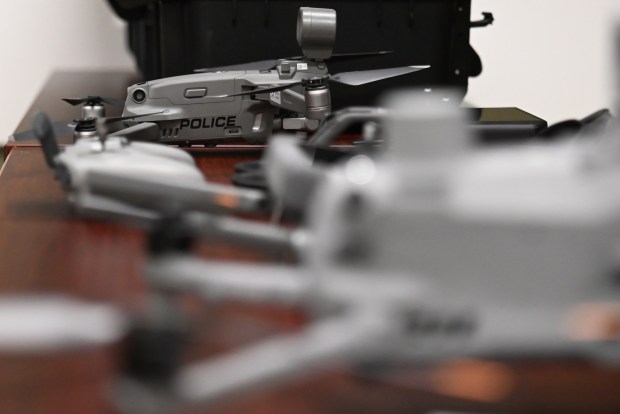 Drones on a table at the Scranton Police Department on Wednesday, Oct. 08, 2025. (REBECCA PARTICKA/STAFF PHOTOGRAPHER)
Drones on a table at the Scranton Police Department on Wednesday, Oct. 08, 2025. (REBECCA PARTICKA/STAFF PHOTOGRAPHER)
With nearly 30 years in the department, Carroll understands the benefits of technology, even on a more basic level.
At the start of his career, Carroll remembers writing down license plate numbers and visually scanning vehicles as he made his way down a city street, first on one side of the road and then on the other after turning his police car around.
Now, each police vehicle has equipment that can read license plates and provide information about the vehicle and its owner. That information can be stored to locate a vehicle in the future.
But Carroll said it is necessary for officers to assess situations in order to get a true understanding of what’s going on. Technology by no means detracts from the importance of well-trained officers and the input of city residents, he said.
Prepared for duty
Lt. James Weaver said virtual Taser training offers a realistic, safe environment for instruction. Previously, the department set up a training area in which officers would fire Taser cartridges into a model or an actor in a special suit.
Virtual tools provide realistic training during which an officer can repeat a scenario if his trainer believes he could have handled it better. A trainer also can set up a scenario to test a certain skill.
Weaver said officers can be called in for a 30-minute training session rather than spending hours away from their duties.
In one virtual training session, officers were called to a domestic dispute during which a woman was reported to have a knife. The woman was depicted as coming out of the house with her hands at her sides. When the officer realized she had a knife, he yelled “knife, knife” and used his Taser.
Following the training, Weaver asked the officer’s reasoning for stunning the woman rather than pulling his gun.
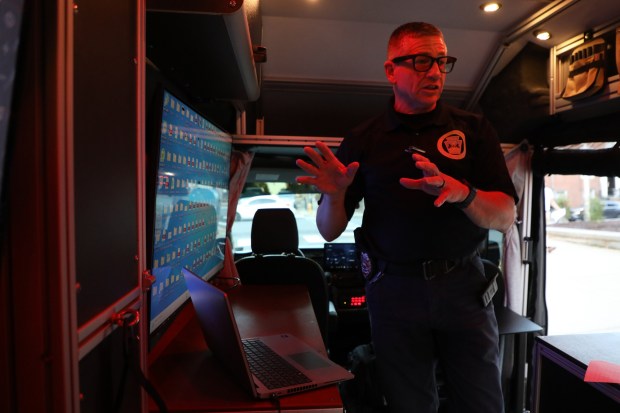 Patrolman Robert Hegedus talks to the Times-Tribune inside the Scranton Police Department’s mobile unit parked outside Scranton’s City Hall on Friday, Oct. 03, 2025. (REBECCA PARTICKA/STAFF PHOTOGRAPHER)
Patrolman Robert Hegedus talks to the Times-Tribune inside the Scranton Police Department’s mobile unit parked outside Scranton’s City Hall on Friday, Oct. 03, 2025. (REBECCA PARTICKA/STAFF PHOTOGRAPHER)
Detective Michael Morrison said a female officer at the scene already pulled her gun, so he felt the safest course was to stun the woman.
Weaver said training scenarios also include follow up decisions. The scenario doesn’t stop with someone being stunned, but continues through the person being arrested and placed in a police vehicle.
Even if an officer acted appropriately, Weaver is likely to ask them to explain. Officers often testify in court about their actions and need to be comfortable in providing reasons why they have made a decision or acted a certain way.
Eye in the sky
Patrol Officer Angel Perez enjoys operating a drone for the department.
Perez used drones as a civilian. He has seen the equipment evolve and become more useful to law enforcement.
The department has two certified drone officers and two officers in training to be drone certified, he said.
Drones can be used for surveillance, search and rescue, crime scene and accident investigation, traffic management and tactical operations.
One of the department’s smaller drones can enter a building and capture what’s going on inside without putting an officer at risk.
“For a prime example, we have a barricaded person. Before we send officers inside the structure, we send our unmanned aircraft system inside the structure to make sure we know the layout of the house and where the suspect might be located,” he said.
A drone might enter a structure and indicate to officers that the building’s first room is clear.
“So SWAT officers would come in and take control of that area,” he said. “So, then we push to the next room and once it’s determined that it cleared, we can keep pushing forward.”
When a suspect is located, officers can maintain surveillance of the room. Information can be provided to team leaders and supervisors so they can make informed decisions, such as sending in a dog or contacting the crisis negotiating team.
The department’s newest drone, the Matrice 14, has remote capabilities, thermal sensors and uses artificial intelligence.
“Let’s say we’re tracking a suspect in the middle of the night. We can track him through the drone,” he said. “If someone is lost in the river, we can send a drone and start searching the area and looking for heat signatures.”
Perez said officers can cover more ground with the drone than on foot.
“I can cover 100 or more yards in two minutes, compared to being on foot,” he said. “Although eventually we have to go in on foot. But, we can do that first canvass right away with the drone.”
The drone also tracks what areas have been searched.
When police use a K9 officer to find a suspect or lost person, the drone can be used to mark the areas where the dog picked up a scent.
The drone image can be seen by the person operating it in the field, but it can also be streamed back to the command center, where other officers can watch it live.
Scranton police response dashboard
A recently installed police data dashboard in Carroll’s office provides regular updates about police activity.
“So, all of our information comes in as a 911 call or stop by a police officer and creates an incident, a service call in the community,” Carroll said. “We’re pulling all that data and we’re analyzing it and putting it onto a map.”
The data shows that police respond to about 4,000 incidents a month, with about 45,000 so far this year.
In general, the department handles 50,000 a year, so this year’s number is expected to be a above average. But, Carroll said those numbers don’t tell the whole story.
For example, there were a significant amount of calls downtown in October. But, looking deeper, he said, only a handful of calls were initiated by a call to 911 indicating a crime. Many were officer initiated incidents during which officers checked on buildings or interacted with people on the street.
But, even that data needs interpretation he said.
Interactions with residents can range from an intoxicated person behaving erratically to an older woman needing help across the street.
“We’re doing a lot, but it’s proactive footing,” he said.
Other data is interesting, but difficult to explain, Carroll said. For example, Wednesdays during October were the busiest days of the week for officers.
Other bits of information seem obvious. For example, early hours — at about 4 or 5 a.m. — are the hours during which officers are least busy.
The system also indicates locations to which police respond the most, the first of which is Scranton Police Headquarters on South Washington Avenue, where residents often walk in to make a report.
Officers also have a heavy presence on the Lackawanna River Heritage Trail, keeping eyes on an area that is often perceived as out of sight, Carroll said.
When the data shows there is a problem in a specific area, more officers patrol that area. During the month of October, more officers were on patrol near Colliery Avenue, after complaints of break-ins near the baseball field.
The data also consistently shows multiple officers on patrol at Weston Field, Sweeney’s Beach and Mulberry Street.
Carroll, who joined the Scranton Police Department in 1997, remembers when the department had a map on the wall and used push pins to indicate incidents of crime. Although that system was adequate, it was slow and labor intensive.
The department’s current technology package was made possible by city funding and state grant money, including $3.5 million received in 2023, specifically for virtual and other training tools and upgrades to body cameras and Tasers.
Lt. James Weaver shows the Taser’s probes as Detective Michael Morrison removes them from the target at the Scranton Police Department on Wednesday, Oct. 08, 2025. (REBECCA PARTICKA/STAFF PHOTOGRAPHER)
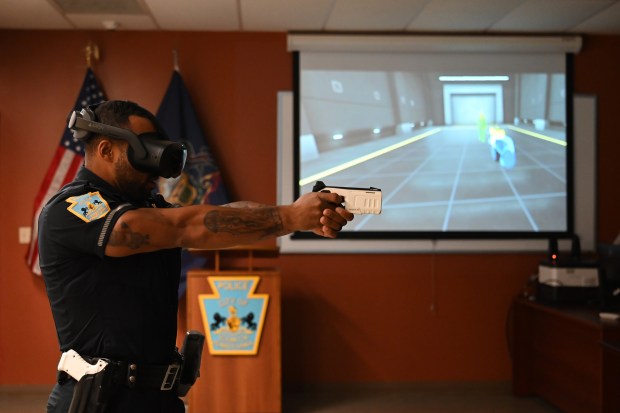
Detective Michael Morrison demonstrates VR training simulator at the Scranton Police Department on Wednesday, Oct. 08, 2025. The screen behind him displays what Morrison sees. (REBECCA PARTICKA/STAFF PHOTOGRAPHER)
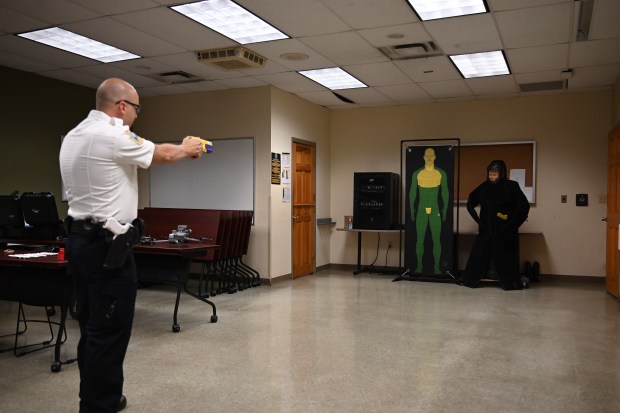
Lt. James Weaver demonstrates a Taser at the Scranton Police Department on Wednesday, Oct. 08, 2025. (REBECCA PARTICKA/STAFF PHOTOGRAPHER)
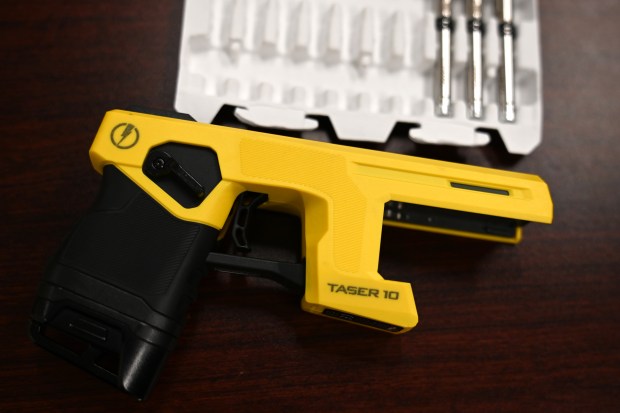
A Taser on the table at the Scranton Police Department on Wednesday, Oct. 08, 2025. (REBECCA PARTICKA/STAFF PHOTOGRAPHER)
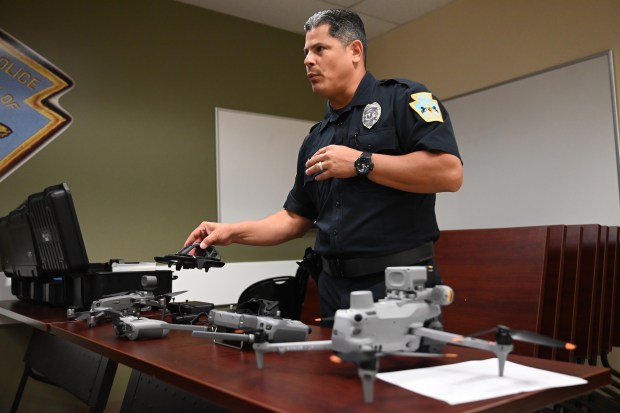
Patrolman Angel Perez talks about the department’s drone technology at the Scranton Police Department on Wednesday, Oct. 08, 2025. (REBECCA PARTICKA/STAFF PHOTOGRAPHER)
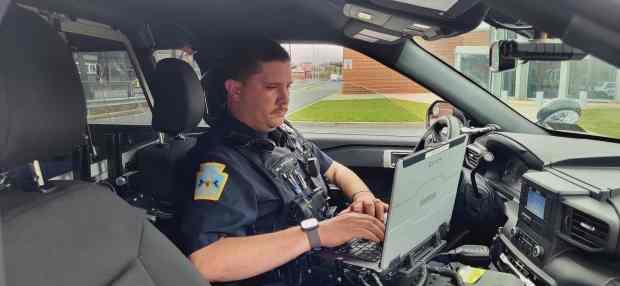
Patrolman Nicholas Philbin enters information into an online system during a patrol shift recent. (GERI GIBBONS/STAFF PHOTO)
Show Caption
1 of 6
Lt. James Weaver shows the Taser’s probes as Detective Michael Morrison removes them from the target at the Scranton Police Department on Wednesday, Oct. 08, 2025. (REBECCA PARTICKA/STAFF PHOTOGRAPHER)
Expand
Mobile command center, fully equipped units
On a recent evening as residents toured Scranton City Hall, Hegedus was stationed in a mobile police unit outside, where he had access to information across the entire city.
Hegedus said the unit with communication and technology equipment could be used for incident management or to oversee an event where a large crowd gathered, such as La Festa Italiana.
In an emergency, police officers can coordinate with personnel, including the Fire Department.
“God forbid there was a major structure fire in town and you need to do an evacuation, you can coordinate police, fire and EMS,” he said. “We can have someone from Pennsylvania ambulance in our truck telling us where the ambulances are.”
As Hegedus stood in the mobile unit, he could identify officers, vehicles and city-mounted cameras.
In the past, oversight of city events was run out of the back of a police vehicle.
“You had no protection from the elements, your power supplies were limited. You didn’t have all this capability,” he said.
A department scribe could also operate out of the mobile unit, recording and documenting actions, decisions and communications during a critical incident such as a standoff, he said.
“Multiple people will work out of multiple work stations,” he said of the mobile unit.
Officers in the mobile unit can also access the body camera of an officer in the field.
The Scranton Police Department is keeping up with the growth of technology and artificial intelligence, he said.
“I’ve been here 17 years and we started out in patrol vehicles with a radio on the floor, lights and sirens,” Hegedus said. “It absolutely is the future coming to Scranton.”
Originally Published: October 19, 2025 at 12:00 AM EDT

